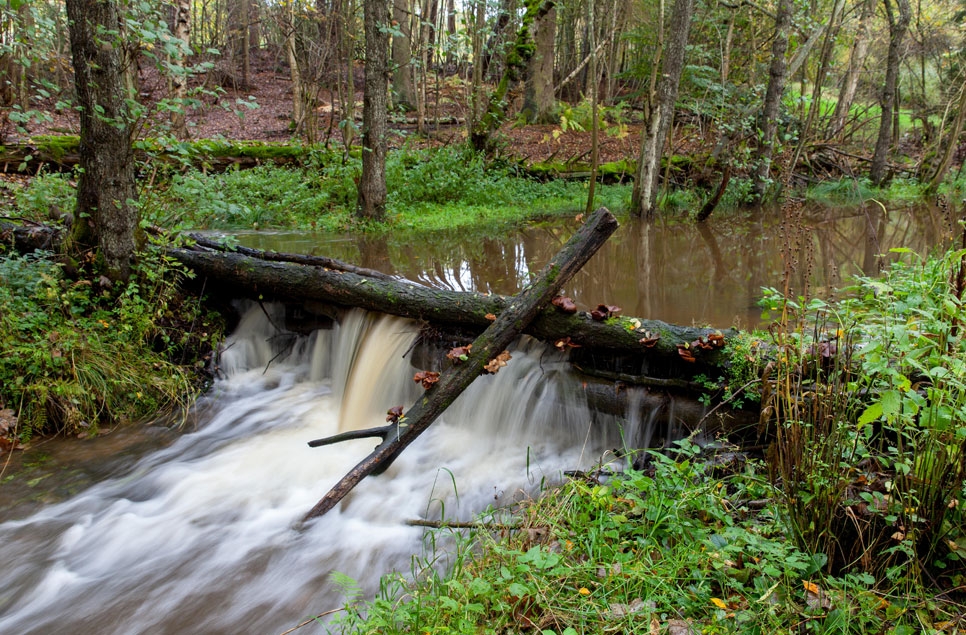A radical rethink on flood protection needed – WWT report
The recent impacts of storms Babet, Ciaran and Debi have exposed how unprepared the UK is to the growing risk of flooding caused by climate change. Our new report is calling on Government to increase the amount they spend on natural flood prevention.

Nature-based solutions must be at the heart of a radical rethink on flood protection.
The recent impacts of storms Babet, Ciaran and Debi have exposed how unprepared the UK is to the growing risk of flooding caused by climate change. Our new report (full report / executive summary) is calling on the Government to increase the amount they spend on natural flood prevention by an extra £130 million per year to help address this.
Currently, only a small percentage of flood prevention schemes in the UK use natural flood management (NFM) where processes such as re-wiggling rivers, restoring wetlands and planting hedgerows, are used to sustainably and effectively slow down and absorb floodwater.
The Government has taken positive steps towards recognising the value of NFM, however out of the £5.2 billion allocated to flood prevention from 2021 to 2027, only a small percentage of that has been awarded to NFM initiativesi.
Instead, the vast majority of the nation’s flood prevention effort is still focused on traditional concrete defences, which while still having a role to play, are often overwhelmed by more frequent and intense flooding, are expensive to build and maintain and don’t provide other benefits.
We're calling for this approach to be radically overhauled as the frequency of extreme weather events increases due to climate change. We want to see government make NFM the default option for flood protection, to make urban and rural communities flood resilient over the long-term. NFM can be used as a stand-alone measure or complement traditional flood defences when placed upstream.
Tom Hayek, Senior Project Manager (Nature-based Solutions) at WWT explained further:
In today’s report, Wetlands for Flood Resilience, we outline how flood prevention policy can be refocused towards NFM.“Flooding is bad for the economy, bad for people and bad for nature. Traditional flood defences often exacerbate problems by diverting floodwater, and the flooding impacts, elsewhere.
“Naturally managing water in the right place is a more effective, more sustainable and less expensive way to manage flood risk. Natural solutions, like wetlands, store water and slowly release it rather than seeing areas inundated whenever heavy rains fall, and provide other benefits such as boosting biodiversity”
Actions WWT is calling for include:
- Increasing the percentage of government funding spent on NFM by 15% over six years – raising an extra £130 million per year
- Funding NFM engagement officers in all local authorities across the UK
- Involving communities in designing and managing local flood protection schemes with nature at their core
- Making flood-alleviation schemes justify why they are not using NFM, coupled with better payments for landowners to incentivise the use of NFM techniques
- Requiring water companies to include NFM investment in their business plans
Climate change is intensifying the misery inflicted on communities by flooding. The insurance costs from Storm Babet alone are estimated at between £450million and £650 millionii. Extended periods of extreme winter rainfall in the UK are now seven times more likelyiii, with one in six propertiesiv, and 60% of our highest quality farmland, in England at risk of floodingv.
Laura Hughes, Manager, General Insurance, Association of British Insurers, said:
“Flooding is the biggest climate threat facing the UK, and we need a range of different approaches to tackle it. Insurers are on the front line in dealing with the distress, disruption and financial loss caused by flooding. We believe nature can help support the UK’s flood defences, as well as having multiple other benefits, and whole-heartedly support WWT’s call to significantly increase investment in natural flood management. Together with sustained targeted and adequate investment by government in flood defence maintenance, this will give our flood risk communities the best possible protection.”
Harnessing the power of natural resources like wetlands to lessen the impact of flooding not only helps keep communities safer, but also creates wildlife havens, stores carbon, cleans water and makes neighbourhoods more pleasant places to live. This in turn helps governments and local authorities meet their nature and climate targets, improves community cohesion and saves businesses money. Up and down the country there are examples of where NFM works. For instance, an NFM scheme in Stroud, Gloucestershire, led to a 1.4 metre drop in storm water levels in a stream that frequently flooded, preventing £1.5 million in damages from a single storm vi. These successful schemes need to be scaled up and increased, so that they become the norm not the exception.
Shelley Formstone, Flood Risk Manager for London (Environment Agency) and a member of the Thames Regional Flood and Coastal Committee said:
“We see the restoration of wetlands and other natural techniques as being key to sustainably protecting today’s Thames communities from the devastating effects of flooding. Currently four million people in the catchment are at risk of floodingvii and the economic impact of a major flood is estimated at £1 billionviii. We are working with WWT to enable and fund local authorities and landowners to ‘mainstream’ Natural Flood Management as part of their flood-risk management plans.”
Natural flood management helps slow the flow of water across a landscape. This can include:
- Restoring wetlands such as saltmarshes and bogs which act as natural sponges
- Reconnecting rivers to restored floodplains to reduce river flooding
- Restoring rivers and streams to a more natural state which can slow down the pace of flood waters reaching towns and cities
- Creating series of smaller wetlands that can collectively reduce flooding across a large rural area
- Sustainable Urban Drainage Systems which manage rainwater in towns and cities using natural features like ponds, permeable surfaces and green areas to slow down flood water
- Planting trees and hedges to absorb more water
The Wetlands for Flood Resilience report also recommends providing
- Funding for increased NFM creation, management and facilitation via a ring-fenced pot within the Flood Defence Grant in Aid scheme
- Centralised guidance and training for land managers, planning authorities and practitioners on how to create and manage wetlands for flood resilience
- A nationally recognised NFM accreditation scheme that sets clear standards for best practice in wetland creation, restoration and maintenance
References
iii. https://www.nature.com/articles/s41586-022-05572-6
vi. https://www.theccc.org.uk/publication/ccc-adaptation-monitoring-framework/
vii. Thames River Basin District Flood Risk Management Plan 2021 to 2027



